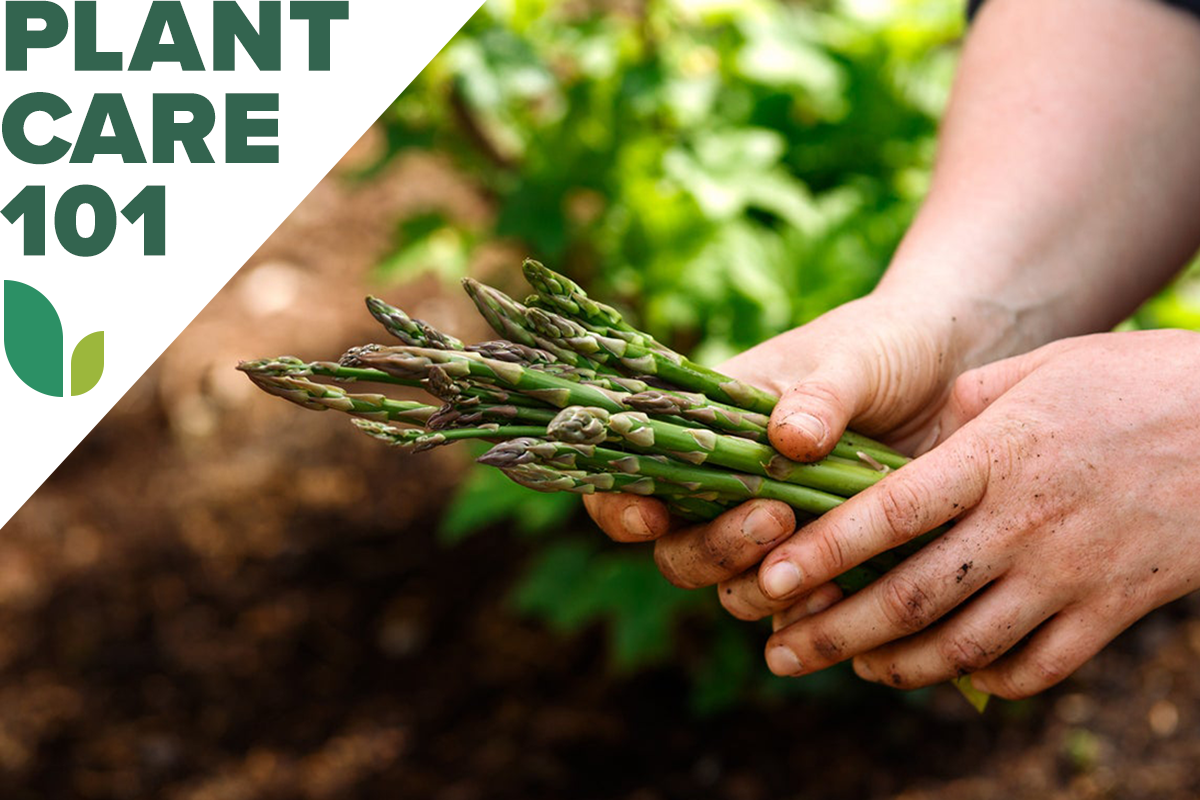

We may earn revenue from the products available on this page and participate in affiliate programs. Learn More ›
If walking through the farmers’ market gives you garden envy, then you know the joy and satisfaction of growing your own veggies. And while you may have mastered growing sweet peas or tomatoes, growing your own asparagus might be the next notch in your gardening belt. Because the plant is perennial and not ready for harvest right away, growing it is a lesson in patience, but that patience comes with a big reward.
If grown properly, fresh asparagus will be gracing your plate for years to come. Here are some tips on the best way to grow asparagus for your garden.
RELATED: 12 Climbing Vegetables That Are Perfect for Compact Gardens
Growing Asparagus at a Glance
Common Name: Asparagus
Scientific Name: Asparagus officinalis
Hardiness Zone: Zones 4 to 9
Soil: Rich, quick-draining soil with a pH of 6.5 to 7
Light: Full sun
Water: Regular water
Food: Feed once in spring and again after harvest
Propagation: Start seeds indoors or propagate from crowns
Safety: Berries produced by female plants in summer are inedible
Asparagus Characteristics
Asparagus (Asparagus officinalis) is unique among veggies because it is one of only a few perennial vegetables. Asparagus spears aren’t ready to harvest until 2 years after planting the asparagus from crowns—1-year-old plant buds and roots—or 3 years after planting asparagus from seed. The edible part of the asparagus plants are the spears, which emerge in springtime from the underground crowns.
A fully grown asparagus plant can live 15 years or even longer, so these edibles require more space and time commitment than the average annual vegetable. But once you learn how to grow asparagus, it is well worth the effort to add them to your vegetable garden.
Once established, asparagus can grow up to 2 inches a day, yielding weeks of delicious, nutritious spears. After harvest, asparagus begin to produce leaves known as ferns, which are quite attractive. These ferns provide energy to the underground buds and roots for next year’s crops. Asparagus plants are dioecious, which means there are both male and female plants. Both are edible, but female plants will produce small, inedible berries in the summer. Female asparagus plants also tend to produce larger spears, whereas male spears are more prolific and the plants live longer.
Recommended Asparagus Varieties
- Mary Washington: The classic, deep-green asparagus you see in grocery stores, this has been one of the most popular varieties in America for decades.
- Purple Passion: This is another popular asparagus that grows beautiful, tender purple spears that become a light green when cooked.
- Apollo: The best variety of asparagus to grow if you like the purple and green types, these large spears are dark green with purple tips and do well in both warm and cool climates.
- Atlas: A vigorous, high-yield asparagus similar to ‘Apollo,’ this plant has medium-to-large green spears with purple tips.
- Jersey Giant: This plant has deep-green spears that can grow to 9 inches long and is resistant to crown rot.
- White Asparagus: This is not a specific variety but rather any variety of asparagus with spears that have been deprived of sunlight after emerging. Blocking the sunlight stunts the production of chlorophyll.
Planting Asparagus
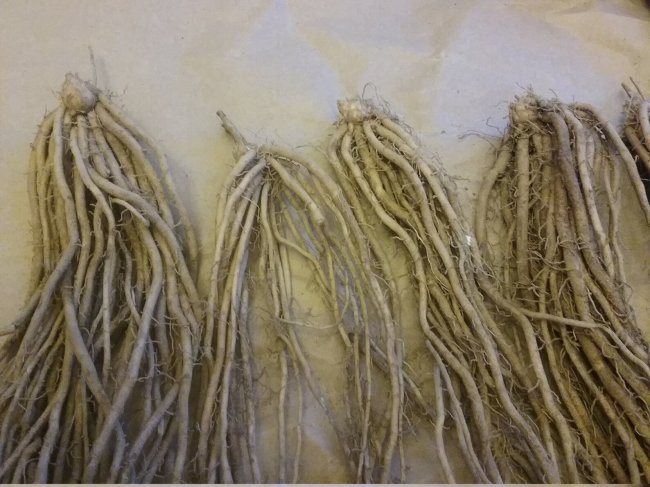
Because asparagus plants can grow for 15 years or longer, choosing the right spot for your asparagus is important. Most gardeners plant asparagus from crowns directly into their permanent bed; however, they can also be grown from seed.
RELATED: 14 of the Fastest-Growing Houseplants for a Nearly Instant Indoor Garden
When is the best time to plant asparagus?
In areas with mild winters, asparagus can be planted in fall or early winter. In areas with cold winters, it should be planted in early spring, usually April or May, when the soil can be worked and after the danger of frost has passed.
Where can asparagus grow?
If starting asparagus from seed directly in the garden, choose a sunny spot that will serve as an asparagus nursery, with enriched soil that can be kept moist and free of weeds. The crowns can be transplanted to a permanent bed the following spring.
If planting asparagus crowns, pick a sunny place in your garden where they can grow successfully and undisturbed, with compost-rich, well-draining soil. Asparagus have deep roots and the crowns grow both vertically and horizontally, so having enough space for your plants is key. Each plant can grow 1 to 3 feet wide and will require 10 to 12 inches’ depth of good, rich soil. For this reason, raised garden beds make an excellent spot for asparagus.
Companion planting for asparagus can include any other sun-loving vegetables, but keep in mind that asparagus ferns can grow between 3 and 8 feet tall. These ferns should not be cut back while green, so be sure the asparagus bed isn’t shading out other veggies in the summer.
RELATED: What Is Companion Planting and How to Use It in Your Home Garden
How do you plant asparagus?
When it comes to how to plant asparagus, there are two ways: from crowns or from seed. Both can be sown directly into the ground. Seeds started indoors 2 to 3 months before the last spring frost should be ready for planting in either a temporary bed where they can grow until the following spring, or directly into the ground in their permanent spot in the garden.
If planting from seed:
- Some seed packets suggest soaking the seeds for 24 hours before planting. Do this according to the package directions.
- Choose a sunny spot in the garden.
- Enrich the soil with compost.
- Plant the seeds according to package directions: usually 1 inch deep and 2 to 3 inches apart.
- Seeds can take 3 weeks to germinate, so be patient and keep the area free of weeds.
- Keep the soil around seeds evenly moist.
- Tend the bed throughout the growing season, keeping plants moist and the bed weed-free.
- Mulch in fall to protect from frost and cold. Do not cut back the ferns.
- If needed, transplant asparagus plants to a permanent garden bed the following spring.
- Feed in spring with an all purpose (10-10-10) fertilizer.
If planting from crowns:
- Before planting, soak the crowns in warm water for at least 2 hours or overnight.
- Enrich the planting soil with compost.
- Dig a trench 12 to 18 inches wide and 8 to 10 inches deep. Space trenches 3 feet apart.
- Make a small mound of rich soil about 2 to 3 inches high down the middle of the trench.
- Place the crowns on this mound of soil in the trench, planting them bud-to-root tip in a line. The buds should be 12 to 18 inches apart.
- Add some all-purpose fertilizer to the soil in the trench.
- Fill in the trench with just 2 to 3 inches of soil. The rest of the soil you removed will be used to cover the asparagus plants as they grow, so don’t remove the soil.
- Keep the soil evenly moist; don’t let it dry out.
- Within 2 to 3 weeks, spears will start to emerge.
- When spears are several inches tall, add some of the extra soil to the trench. Make sure the soil is tilled well and be careful while adding, as young asparagus spears can break easily.
- As tempting as it is, do not harvest any of these spears.
- As ferns start to emerge, fill in the remaining soil.
- Mulch lightly to help retain moisture and control weeds. The best mulch for asparagus is one that is soft enough for the shoots to grow through (for example, straw versus bark).
- Continue to weed and water throughout the season.
- In areas with cold winters, mulch heavily in the fall to protect from frost.
Can you grow asparagus in containers?
Asparagus doesn’t do well in small pots or containers. However, there are a variety of DIY vegetable gardens with raised beds where asparagus will thrive. The key is to make sure the bed has at least 2 feet of soil depth and is as long as the number of plants you wish to grow. For example, if you want to plant six plants, the bed should be at least 6 feet long and 3 to 4 feet wide.
Watering Asparagus
Established asparagus plants like regular, consistent water, but be careful not to overwater them. Water deeply whenever the soil dries out at root depth, which is usually several inches below the soil. For new plants and seedlings, water more frequently, when soil is dry 2 to 3 inches below the soil.
Fertilizing Asparagus
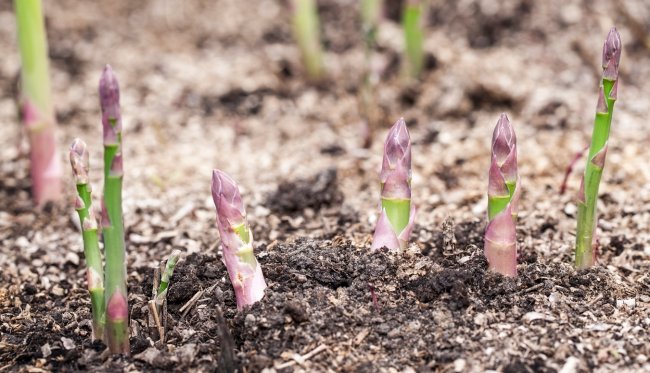
Asparagus plants can grow in medium-to-sandy soil, and heavy clay soils should be amended. Asparagus doesn’t like acidic soil. Before the spears start to emerge in early spring, apply a fertilizer that has both phosphorus and potassium. An all-purpose garden fertilizer, such as a 10-10-10, will also work. After harvest in later summer, fertilize again with a mix that is higher in nitrogen (the first number should be higher than the other two).
RELATED: How to Test Soil pH
Pruning Asparagus
Prune according to the stages of growing asparagus. Do not cut back the ferns while green because they are gathering energy and nutrients for the roots; cutting off the ferns is like cutting off their food supply. Cut ferns back to about 2 inches in the late fall once all of the ferns have gone brown or yellow.
Propagating Asparagus
Asparagus can be propagated from seed. An established (female) plant will produce red berries, which can be harvested before the first frost. These berries are inedible but can be crushed to extract their asparagus seeds, which should then be soaked to remove any flesh from the berry, dried out, and saved to plant the following spring. Asparagus seeds are also available at garden centers and nurseries. Since asparagus seeds can take up to 3 weeks to germinate, those in areas with colder winters and shorter growing seasons may want to start the seeds indoors.
Asparagus cannot be harvested until after the second year of growth, so many gardeners prefer to plant the crowns directly. As asparagus become more established, the plants can also be propagated by division. Dig the root up in late fall after the ferns have died back, and cut the root into several pieces. Plant the asparagus right away before the first frost or save it in a cool, dry place until the following spring.
RELATED: 12 Little-Known Tricks to Make This Year’s Vegetable Garden a Success
Safety Considerations
Female plants produce red berries in summer. These berries are toxic to humans, so be sure to keep small children and pets away from the asparagus growing in a bed when the plants are fruiting. Just a few berries can cause vomiting and indigestion. If harvesting seeds from the berries, it’s best to wear gloves and wash hands thoroughly afterward.
Potential Pests and Diseases
If your asparagus spears appear to have brown spots and scarring, or if the shoots bend over, they may be victims of asparagus beetles. Yellow or orange spots on asparagus stems may be asparagus rust, while purple spots on the spears or light-brown and purple spots on the stems is called Stemphylium, or purple spot. Another common disease is fusarium crown rot, a fungus that stunts growth, turns the crowns brown, and causes leaves to yellow before autumn.
Harvesting Asparagus
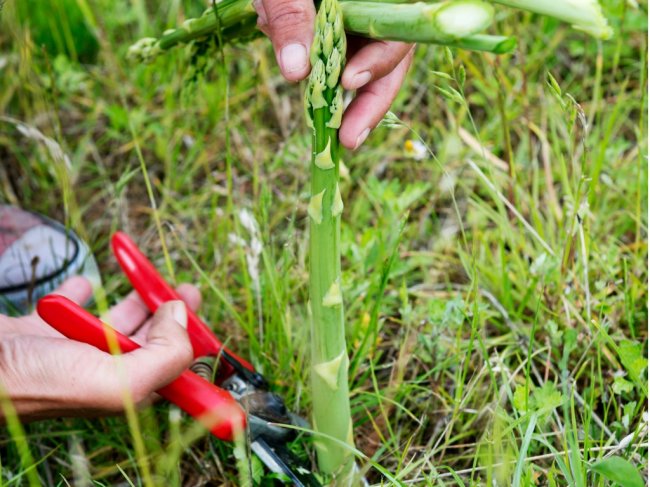
Asparagus can be harvested either the third year after planting from seed or the second year after planting from crowns. For example, if you plant crowns in April, the following April you will not harvest. Continue to care for the asparagus plants throughout the year, and the second spring and summer you can begin to harvest sparingly.
When is the best time to harvest asparagus?
It’s best to harvest asparagus early in the season while the spears are tender. Harvest spears when they are 6 to 8 inches long. The first year of harvest, pick asparagus sparingly and only for the first 2 weeks or so of growth. Let the ferns grow in and strengthen the plants.
If the plants are not robust, wait to harvest in the third year, giving plants even more time to strengthen underground. Some gardeners will only harvest the first month of the third year to give the plants more time to grow.
How do you harvest asparagus?
Once the plants have matured enough to harvest, your patience will finally be rewarded. Wondering how to cut asparagus? Use a clean, sharp kitchen knife or pair of scissors for smaller plants.
- Cut or snap off spears as close to the roots as possible.
- Be careful not to disturb roots.
- Rinse asparagus and store (or eat fresh right then).
- Waiting too late in the season to harvest will result in tough asparagus.
How do you store asparagus?
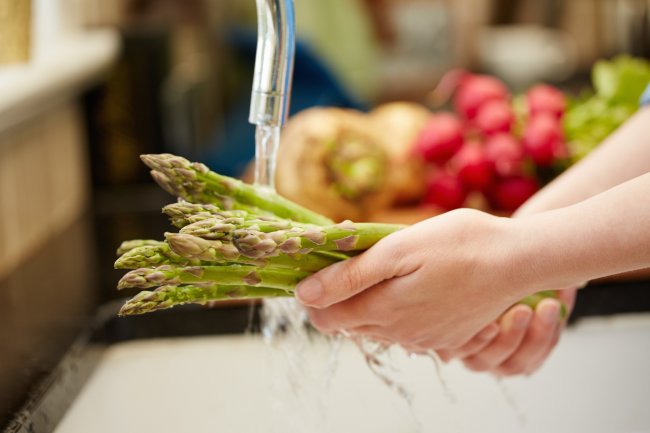
For maximum flavor and nutrients, asparagus is best eaten within 1 week of picking. Store asparagus in the refrigerator in an airtight container. Asparagus can also be frozen shortly after harvesting in freezer bags. Be sure asparagus is rinsed and dried completely before freezing, and it can be cut into smaller pieces before freezing.
Looking for more edible plants to grow? Check out our guides on growing potatoes, cucumbers, and peas.
